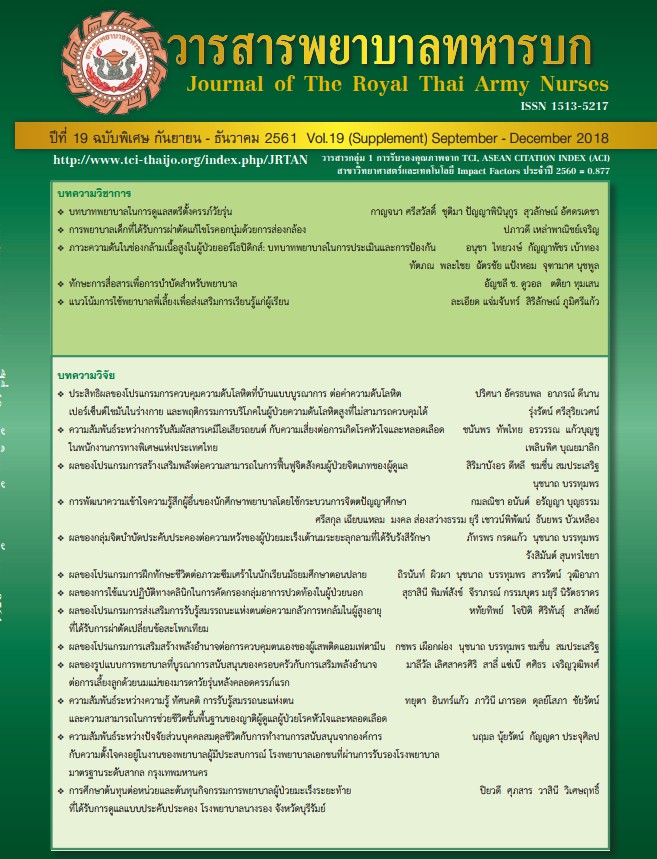The situation of Modified Electroconvulsive Therapy in psychiatric patients in Galya Rajanagarindra Institute
Keywords:
adverse effects, complications, electroconvulsive therapy, psychiatric illnessAbstract
The present study aimed to identify the situations of the modified electroconvulsive therapy in psychiatric patients, investigating the relationship and predictive power of the factors predicting adverse effect and complications of the modified electroconvulsive therapy in psychiatric patients. The study sample consisted of 175 psychiatric patients received modified electroconvulsive therapy. Data were collected by using demographic data, history illness, information relating to electrical therapy, adverse effect and complications data of Modified Electroconvulsive Therapy in psychiatric patients. Data were analyzed using descriptive analysis, chi-square test and logistic regression. The study found that most of the patients were 62.3 % male, 29.2 % had body mass index ≥ 25 (overweight or obese). 72 % of psychiatric patients were diagnosed in schizophrenia. 42.3 % had comorbidity. Body Mass Index (BMI) and Clozapine treatment were positively significant correlated with the adverse effects and complications of the modified electroconvulsive therapy at the .05 level. Non-responding to medical treatment was significant correlated with the adverse effects and complications of the modified electroconvulsive therapy at the .01 level. Result found that the BMI level more than 30 can predict the adverse effects and complications of the modified electroconvulsive therapy at the .01 level. The variance expand of this predictive factor was 18.9 Findings from this study could be used as a foundation for nursing planning in reducing the adverse effects and complications from the Modified Electroconvulsive Therapy in psychiatric patients, especially overweight or obese patients receiving clozapine and patients not responding to therapy. Therefore, nurses should develop the nursing practice guidelines for overweight or obese patients treated with modified electroconvulsive therapy to reduce the adverse effects or complications of the modified electroconvulsive therapy.
Downloads
References
2. Subedi S, Aich TK, Sharma N. Use of ECT in Nepal: a one year study from the country’s largest psychiatric facility. J Clin Diagn Res. 2016 Feb;10(2):VC01-VC04. doi: 10.7860/JCDR/2016/14660.7269. PubMed PMID: 27042563; PubMed Central PMCID: PMC4800629.
3. Leelananakit T. Electroconvulsive Therapy (ECT); theory and practice. 1st ed. Bangkok: Thammasat Printing House; 2010. (in Thai).
4. Grover S, Chakrabarti S, Hazari N, Avasthi A. Effectiveness of electroconvulsive therapy in patients with treatment resistant schizophrenia: a retrospective study. Psychiatry Res. 2017;249:349-53.
5. Napapongsuriya T. Chapter 9: Electroconvulsive therapy. In: Seeherunwong A, Yuttatri P, Kaesornsamut P, Thanoi W, editors. Psychiatric nursing. 1st ed. Bangkok: Amarin Printing & Publishing; 2014. p.151-60. (in Thai).
6. Wannamanee S. Patient distress from electroconvulsive therapy at Suan Prung Psychiatric Hospital [master’s thesis]. Chiang Mai: Chiang Mai University; 2005. 63 p. (in Thai).
7. Andrade C, Arumugham SS, Thirthalli J. Adverse effects of electroconvulsive therapy. Psychiatr Clin North Am. 2016;39(3):513-30.
8. Martin M, Gálvez V, Loo CK. Predicting retrograde autobiographical memory changes following electroconvulsive therapy: relationships between individual, treatment, and early clinical factors. Int J Neuropsychopharmacol. 2015 Jun 19;18(12). pii: pyv067. PubMed PMID: 26091817; PubMed Central PMCID: PMC4675978.
9. Suvarnarong K, Vongsirimas N. Chapter 8: Electroconvulsive therapy and nursing care. In: Sitthimongkol Y, Kaesornsamut P, Vongsirimas N, Au-Yeong PA, editors. Psychiatric nursing. 2nd ed. Bangkok: Scan Art; 2016. p.133-48. (in Thai).
10. Surve R, Bansal S, Sriganesh K, Subbakrishna DK, Thirthalli J, Umamaheswara Rao GS. Incidence and risk factors for oxygen desaturation during recovery from modified electroconvulsive therapy: a prospective observational study. J Anaesthesiol Clin Pharmacol. 2015;13(1): 99-103.
11. Reti IM, Krishnan A, Podlisky A, Sharp A, Walker M, Neufeld KJ, et al. Predictors of electroconvulsive therapy postictal delirium. Psychosomatics. 2014;55(3):272-9.
12. Ittasakul P. Risk of overweight and obesity in psychiatric patients. Ramathibodi Medical Journal. 2012;35(2):67-9. (in Thai).
13. Elias A, Phutane VH, Clarke S, Prudic J. Electroconvulsive therapy in the continuation and maintenance treatment of depression: systematic review and meta-analyses. Aust N Z J Psychiatry. 2018;52(5):415-24.
14. Prudic J, Haskett RF, Mulsant B, Malone KM, Pettinati HM, Stephens S, et al. Resistance to antidepressant medications and short-term clinical response to ECT. Am J Psychiatry. 1996; 153(8):985-92.
15. Brus O, Cao Y, Gustafsson E, Hulten M, Landen M, Lundberg J, et al. Self-assessed remission rates after electroconvulsive therapy of depressive
disorder. Eur Pychiatry. 2017;45:154-60.
16. Slade EP, Jahn DR, Regenold WT, Case BG. Association of electroconvulsive therapy with psychiatric readmissions in US hospital. JAMA Psychiatry. 2017;74(8):798-804.
17. Nualsuth N, Musiko S, Sarapong N. Pain of psychiatric patients undergoing electroconvulsive therapy and pain management of professional nurses: a case study of Sansaranrom Hospital. Surat Thani: Suansaranrom Hospital Nursing Group; 2010. (in Thai).
18. Krejcie RV, Morgan DW. Determining sample size for research activities. Educ Psychol Meas. 1970;30:607-10.
19. Trakada G, Velentza L, Konsta A, Pataka A, Zarogoulidis P, Dikeos D. Complications of anesthesia during electroconvulsive therapy due to undiagnosed obstructive sleep apnea: A case-study. Respiratory Medicine Case Reports. 2017;20:145-49.
20. Hirachan A, Maskey A. Acute myocardial infarction following electroconvulsive therapy in a Schizophrenic patient. Egypt Heart J. 2017; 69(1):71-3.
21. Thongpramoon W. Factors related to oxygen desaturation in patients receiving anesthesia for operations in the post-anesthetic care unit at Nakhon Nayok Hospital. Nursing Journal of the Ministry of Public Health. 2015;25(3): 120-31. (in Thai).
22. Thomma-aksorn P, Siriussawakul A. Anesthesia for obese patients. Siriraj Medical Bulletin. 2017;10(1):34-41.
23. Ward HB, Szabo ST, Rakesh G. Maintenance ECT in schizophrenia: a systematic review. Psychiatry Res. 2018;264:131-42.
24. Waite J, Easton A. The ECT handbook. 3rd ed. London, UK: The Royal College of Psychiatrists; 2013.
25. Grover S, Hazari N, Kate N. Combined use of clozapine and ECT: a review. Acta Neuropsychiatrica. 2015;27(3):131-42.
Downloads
Published
How to Cite
Issue
Section
License
บทความหรือข้อคิดเห็นใดใดที่ปรากฏในวารสารพยาบาลทหารบกเป็นวรรณกรรมของผู้เขียน ซึ่งบรรณาธิการหรือสมาคมพยาบาลทหารบก ไม่จำเป็นต้องเห็นด้วย
บทความที่ได้รับการตีพิมพ์เป็นลิขสิทธิ์ของวารสารพยาบาลทหารบก
The ideas and opinions expressed in the Journal of The Royal Thai Army Nurses are those of the authors and not necessarily those
of the editor or Royal Thai Army Nurses Association.






